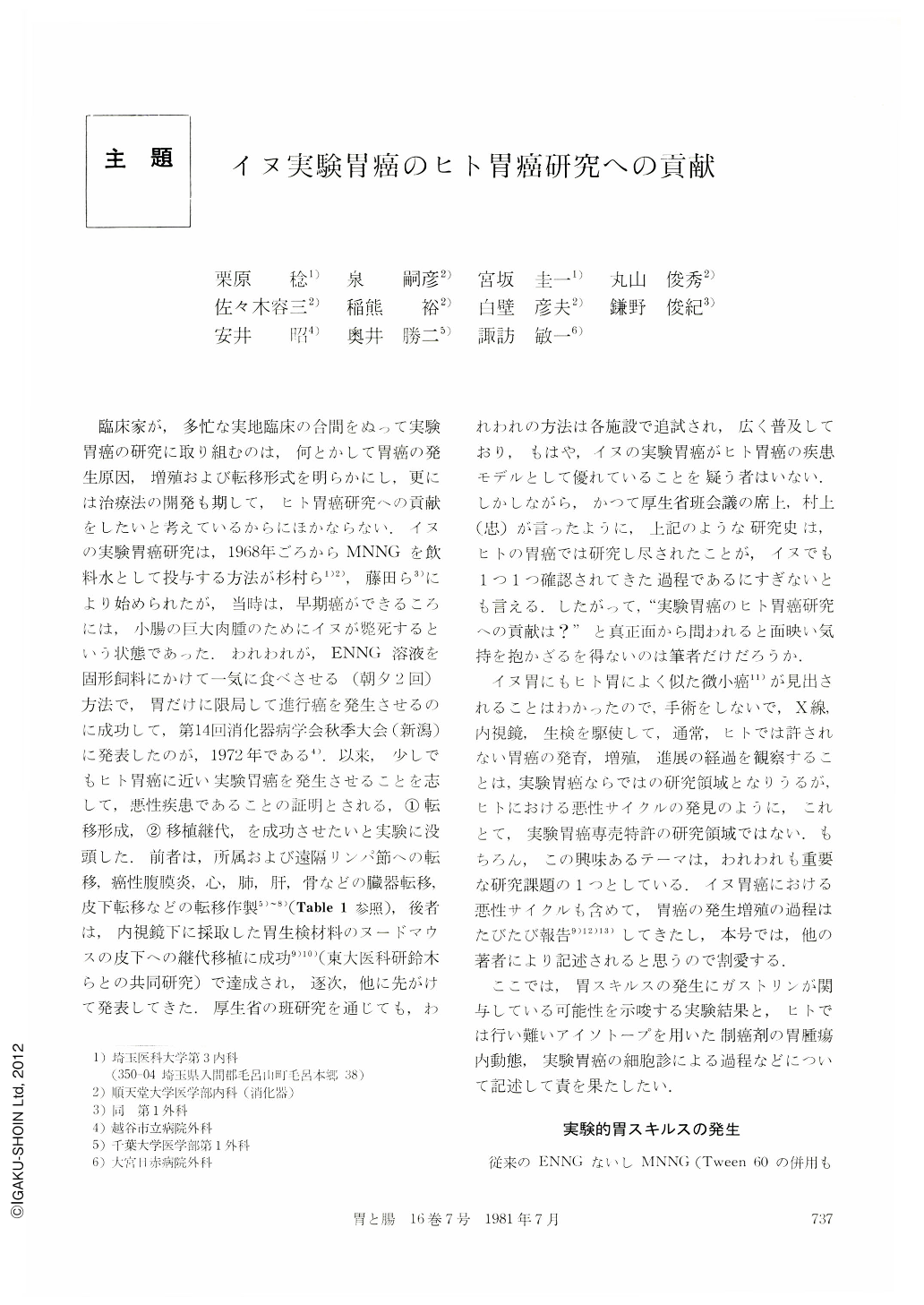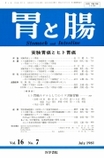Japanese
English
- 有料閲覧
- Abstract 文献概要
- 1ページ目 Look Inside
臨床家が,多忙な実地臨床の合間をぬって実験胃癌の研究に取り組むのは,何とかして胃癌の発生原因,増殖および転移形式を明らかにし,更には治療法の開発も期して,ヒト胃癌研究への貢献をしたいと考えているからにほかならない.イヌの実験胃癌研究は,1968年ごろからMNNGを飲料水として投与する方法が杉村ら1)2),藤田ら3)により始められたが,当時は,早期癌ができるころには,小腸の巨大肉腫のためにイヌが斃死するという状態であった.われわれが,ENNG溶液を固形飼料にかけて一気に食べさせる(朝夕2回)方法で,胃だけに限局して進行癌を発生させるのに成功して,第14回消化器病学会秋季大会(新潟)に発表したのが,1972年である4).以来,少しでもヒト胃癌に近い実験胃癌を発生させることを志して,悪性疾患であることの証明とされる,①転移形成,②移植継代,を成功させたいと実験に没頭した.前者は,所属および遠隔リンパ節への転移,癌性腹膜炎,心,肝,骨などの臓器転移,皮下転移などの転移作製5)~8)(Table1参照),後者は,内視鏡下に採取した胃生検材料のヌードマウスの皮下への継代移植に成功9)10)(東大医科研鈴木らとの共同研究)で達成され,逐次,他に先がけて発表してきた.厚生省の班研究を通じても,われわれの方法は各施設で追試され,広く普及しており,もはや,イヌの実験胃癌がヒト胃癌の疾患モデルとして優れていることを疑う者はいない.しかしながら,かつて厚生省班会議の席上,村上(忠)が言一,ように,上記のような研究史は,ヒトの胃癌では研究し尽されたことが,イヌでも1つ1つ確認されてきた過程であるにすぎないとも言える.したがって,"実験胃癌のヒト胃癌研究への貢献は?"と真正面から問われると面映い気持を抱かざるを得ないのは筆者だけだろうか.
イヌ胃にもヒト胃によく似た微小癌11)が見出されることはわかったので,手術をしないで,X線,内視鏡,生検を駆使して,通常,ヒトでは許されない胃癌の発育,増殖,進展の経過を観察することは,実験胃癌ならではの研究領域となりうるが,ヒトにおける悪性サイクルの発見のように,これとて,実験胃癌専売特許の研究領域ではない.もちろん,この興味あるテーマは,われわれも重要な研究課題の1つとしている.イヌ胃癌における悪性サイクルも含めて,胃癌の発生増殖の過程はたびたび報告9)12)13)してきたし,本号では,他の著者により記述されると思うので割愛する.
Production methods of gastric adenocarcinoma in mongrel dogs and beagles by oral administration of a dried pellet diet soaked in N-ethyl-N'-nitro-N-nitrosoguanidine (ENNG) solution have been estab lished. Gastric carcinoma was more rapidly and successfully induced by these methods than by the other methods described by Sugimura et al and Fujita et al, using N-methyl-N'-nitro-N-nitrosoguanidine (MNNG).
Metastases of the ENNG-induced adenocarcinoma cells to the distant lymph nodes as well as regional lymph nodes were observed in mongrel dogs and beagles. Sarcomas of the upper parts of the small intestines occurred not infrequently in experiments with MNNG, while in the ENNG experiments they were not observed. Secondary deposits in the liver were also observed in two beagles.
Histologically, carcinomas were composed of poorly differentiated adenocarcinoma, signet-ring cell carcinoma, tubular adenocarcinoma, and undifferentiated adenocarcinoma. Not only successful metastases of tumors to the lymph nodes and other organs, but also succesful transplantation of tumors to other animals has been regarded over the years as of the utmost significance as a test for malignancy.
Heterotransplantation of ENNG induced dog stomach carcinoma to nude mice was also successful (Acta path jpn, 26: 481~489, 1976) Moreover, development of scirrhous carcinoma in dogs by the combined use of ENNG and subcutaneous injection of gastrin was found in three of the ten beagles. They were found to have annulary infiltrating advanced carcinoma with marked fibrous thickening of the antral wall resulting in stenosis of the antrum (carcinoma scirrhosum) which resembled Borrmann's type 4 carcinoma in the human stomach.
In order to confirm with the experimental basis that an oral administration of anti-cancer agents has effects on gastric cancer, 14C-5-FU was orally and intravenously administered to dogs with gastric cancer induced by ENNG. In this study, 5-FU level was higher in cancer tissues than in normal tissues. Furthermore, 5-FU level in the oral administration was higher than that in the intravenous administration.
In this case,5-FU level was higher both in the surface layer and the deep layer of cancer tissues mucosa than in those of normal tissues. This fact was also recognized in macroautoradiography on the cut surface of resected gastric cancer. Similar experiment with UFT is now underway. After six hours of oral administration of UFT to a dog with gastric cancer induced by ENNG, 5-FU concentration of autopsied organs was measured. In this case, 5-FU level was higher in the gastric cancer and the lung than in other organs. Okui et al, have just started to study cytological research about touch smears of biopsy materials of dog carcinoma. After the staining the touch smears by the Papanicolaou's method, the same specimens were stained by Feulgen's method to study DNA analysis. In the future the relation of cytological diagnosis with DNA analysis should be come clear.

Copyright © 1981, Igaku-Shoin Ltd. All rights reserved.


